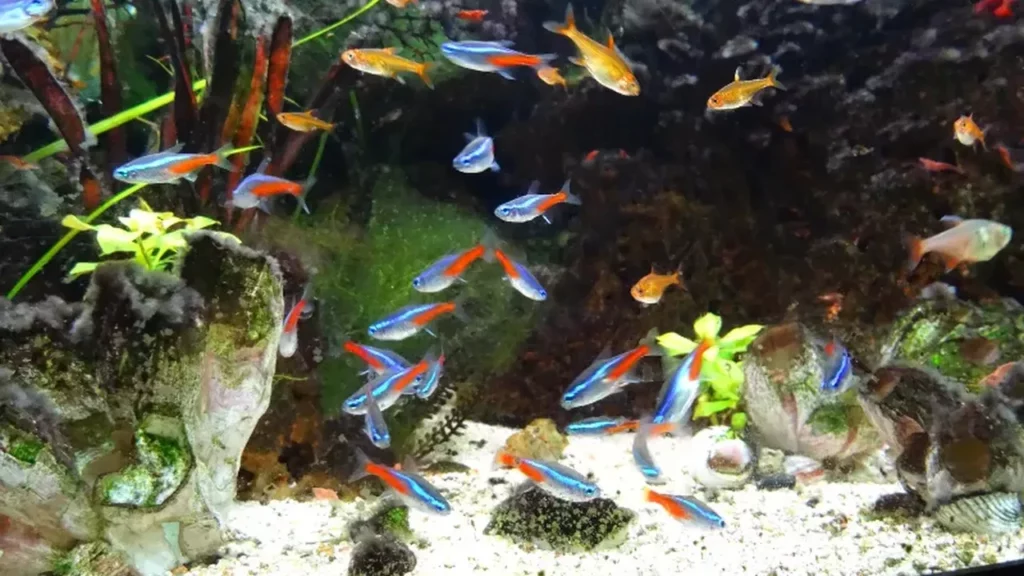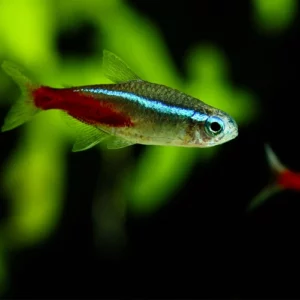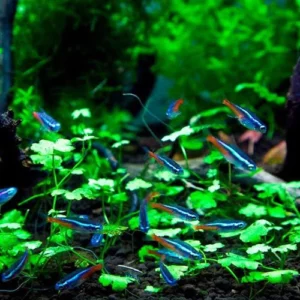Are Neon Tetras Livebearers Or Egg Layers?
Neon Tetras are egg-laying fish. They engage in a unique courtship ritual where males often dance to woo females before the act of spawning. Females can lay between 60 to 130 eggs in one session, depositing them on broad-leaved plants or other suitable surfaces in the aquarium. These eggs are small, adhesive, and translucent. It typically takes about 24 hours for the eggs to hatch into fry. To encourage spawning in captivity, the water conditions should mimic their natural Amazonian habitat with a temperature of 75°F to 80°F (24°C to 27°C), a pH of 5.0 to 7.0, and soft water. Dimmed lighting and plants provide a conducive environment.
Home » Guides » Fish Care » Neon Tetra » Are Neon Tetras Livebearers Or Egg Layers?
Neon Tetra Fact Sheet
| Scientific Name | Paracheirodon innesi |
| Common Name | Neon Tetra, Neons |
| Care Difficulty | Easy |
| Life Expectancy | 3-10 Years |
| Average Size | 1.5 Inches (3.8cm) |
| Temperature | 72°F – 82°F (22°C -28°C) |
| Diet | Omnivore |
| Behavior | Friendly/Peaceful |
| Breeding | Medium/Hard |
| pH | 6-7.5 |
| Live Plant Friendly | Yes |
Understanding Reproductive Methods in Fish
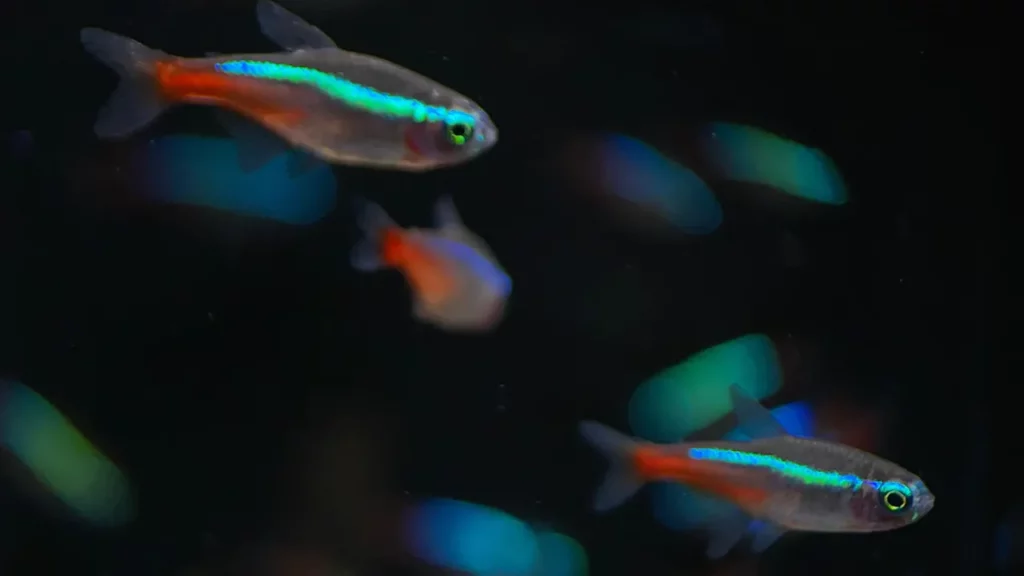
Livebearing Explained
Livebearing Explained
In the grand tapestry of fish species, many have evolved to reproduce by releasing eggs into the water, which then become fertilized and eventually hatch into baby fish, or fry. However, some fish, like the livebearers, have taken a different route. Instead of laying eggs externally, these fish internally fertilize their eggs, allowing the embryos to develop within the mother’s body.
As a result, these vivacious livebearers give birth to fully-formed, free-swimming young, which are ready to explore their new aquatic world from the get-go. This reproductive strategy is analogous to mammals giving birth to live offspring, but, of course, in the unique, watery context of the fish world.
Imagine being an aquarist and watching this wondrous moment unfold in your own tank. One moment, your fish is gracefully navigating its watery domain, and the next, a brood of tiny fish are darting about, with the same spark of life as their parent. The advantage of livebearing is evident here: the offspring are already mobile and relatively more developed than newly-hatched fry from eggs, giving them a potential edge in survival.
Now, while the thought of fish giving birth might conjure images of complex pregnancy, it’s essential to remember that fish do not undergo pregnancy in the same manner as mammals. They don’t have a placental connection to nourish the young, for example. Instead, the embryos develop in specialized structures inside the mother, nourished by yolk from the egg.
But why would some fish evolve to be livebearers? The answer lies in the delicate balance of survival. In some environments, laying eggs might expose the potential offspring to a higher risk of predation or adverse conditions. By giving birth to live young, the mother fish can offer them a brief head start in life, potentially increasing their chances of survival.
Egg-laying Explained
Egg-laying Explained
Most of the fish species in our vast aquatic world reproduce by laying eggs. This process is often referred to as “oviparity.” Picture this: amidst the underwater ballet of darting fish and swaying plants, a pair of fish start their delicate dance. The female releases her eggs, often in hundreds or even thousands, into the water or onto a surface. Following suit, the male releases his milt, containing sperm, to fertilize those eggs. The dance of life has thus been set in motion.
The choice of laying eggs offers several advantages. Firstly, it allows fish to produce a significantly large number of offspring at once, casting a broad net (pun intended!) for the survival of their genes. It’s a bet on quantity over the protective strategy of livebearers.
But it isn’t just a matter of laying and leaving. Oh no, nature’s script is far too intricate for that. Many species have evolved intricate rituals and behaviors to ensure their eggs’ survival. Some fish, like the devoted cichlids, guard their nests fiercely. Others, like the fascinating mouthbrooders, carry their eggs (and even fry) in their mouths, offering them a safe haven from would-be predators.
The eggs themselves are tiny wonders. Depending on the species, they can be adhesive, sticking onto surfaces to minimize the risk of being swept away. Others might be buoyant, floating up to find solace amidst floating plants or the water’s surface. And inside these eggs? A miniature universe! The embryo develops, drawing nourishment from the yolk sac, gradually transforming from a tiny speck into a recognizable baby fish.
The duration of this metamorphosis varies among species, with some eggs hatching within a day or two, while others might take weeks. But regardless of the time, the moment of hatching is nothing short of miraculous. Out emerges the fry, fragile yet brimming with life’s potential, ready to embark on its aquatic adventure.
Neon Tetras: Egg Layers
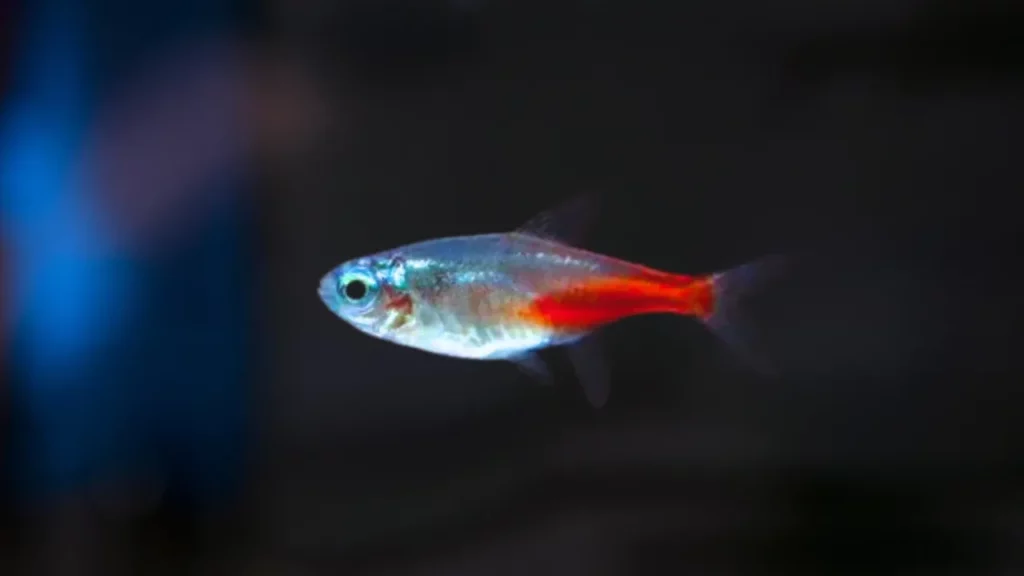
The Spawning Process
The Spawning Process of Neon Tetras
Neon Tetras, with their iridescent blue and fiery red stripes, aren’t just a treat for the eyes. They’re a testament to nature’s meticulous choreography. Allow me to guide you through their spawning dance, a ballet of color and grace.
The Prelude: Just like in a grand theater, lighting plays a crucial role. Neon Tetras prefer subdued lighting during spawning. It’s as if they desire a romantic ambiance to set the mood. In the wild, the soft filtering of sunlight through dense Amazonian canopies provides this setting. In captivity, we can mimic this by reducing the aquarium light or using floating plants.
The Dance: The courtship is subtle, yet profound. The male, in his radiant best, begins to display a more intense coloration. He dances around the female, showing off his vibrant hues, trying to win her affection. If she’s receptive, the female responds by aligning her body next to his. It’s a silent, underwater tango.
The Crescendo: Once their aquatic duet reaches its peak, the female releases her eggs, and the male quickly fertilizes them. Neon Tetras are scatter spawners, which means they don’t have a specific nesting site. Instead, the eggs are released freely, often amidst fine-leaved plants, providing them some concealment and protection. This scatter-spawning ensures a higher chance of survival for the eggs, as predators would find it difficult to consume them all.
It’s essential to note that neon tetras, in their zeal of reproduction, might consume their eggs. It’s an instinct, a paradox of nature where they ensure the fittest survive. In captivity, if breeders wish to raise a brood, they often remove the parents post-spawning or provide a mesh at the tank’s bottom, allowing the eggs to fall through, out of the parents’ reach.
Characteristics of Neon Tetra Eggs
Characteristics of Neon Tetra Eggs
Size: Neon Tetra eggs are minute, typically measuring about 0.8 to 1.2 mm in diameter. To the untrained eye, they might seem like mere specks amidst the aquarium substrate or plants. But rest assured, within these tiny capsules, life is stirring.
Color: Freshly laid Neon Tetra eggs possess a translucent, almost pearly hue. This transparency offers a unique window into the embryonic development, allowing keen observers to witness the miracle of life in its earliest stages. As the embryos mature, a tiny dark spot, the forming eyes, becomes visible.
Placement: Neon Tetras, in their inherent wisdom, scatter their eggs amongst fine-leaved aquatic plants. Think of plants like Java Moss or Water Wisteria providing a delicate meshwork, where these eggs find refuge. This strategic placement ensures not just concealment from potential predators, but also a stable environment, minimizing disturbances from water currents.
Adhesiveness: Another fascinating trait of these eggs is their adhesiveness. When first released, the eggs are slightly sticky, allowing them to cling to the aquatic plants or even the aquarium walls and decorations. This adhesiveness, albeit temporary, ensures the eggs remain anchored, safe from being swept away by water currents.
Viability: Now, not every egg will harbor life. Non-fertilized eggs or those that begin to decay often turn a cloudy, opaque white. This is nature’s way of telling aquarists that these particular eggs won’t be producing fry. Regular monitoring is essential, for it’s prudent to remove such eggs to prevent them from becoming a breeding ground for fungus or bacteria, which might jeopardize the healthy eggs.
Duration Until Hatching
Duration Until Hatching
Timeframe: Once the Neon Tetra eggs are laid and fertilized, the countdown begins. Typically, in optimal conditions, the eggs will hatch within 24 to 48 hours. Yes, in merely a day or two, those minute, translucent orbs transform into wriggling fry!
Temperature’s Role: The water temperature plays a pivotal role in determining the hatching duration. Neon Tetras, hailing from the tropical waters of the Amazon, prefer a warmer setting. At an ideal temperature range of 74°F to 78°F (or 23°C to 25°C), the eggs will hatch within the above-mentioned timeframe. However, if the water is cooler, the hatching might be delayed, and if it’s too warm, it might expedite the process – but be wary, as temperatures that are too high or low can affect the health and survival rate of the fry.
First Glimpse of Fry: When the eggs finally hatch, the fry are not the shimmering miniatures of their parents. Instead, they are tiny, fragile, and translucent beings, almost larvae-like. Initially, they are not free-swimming and often attach to surfaces using adhesive glands on their heads. It’s a phase of vulnerability, as they depend on their yolk sacs for nourishment.
Onward Journey: After about 3 to 4 days post-hatching, once the yolk sac is consumed, these fry venture into the water column, starting their journey as free-swimming Neon Tetras. It’s only after a few weeks, with proper care and nutrition, that they begin to showcase the first hints of their iconic neon colors.
Differentiating Between Livebearers and Egg Layers
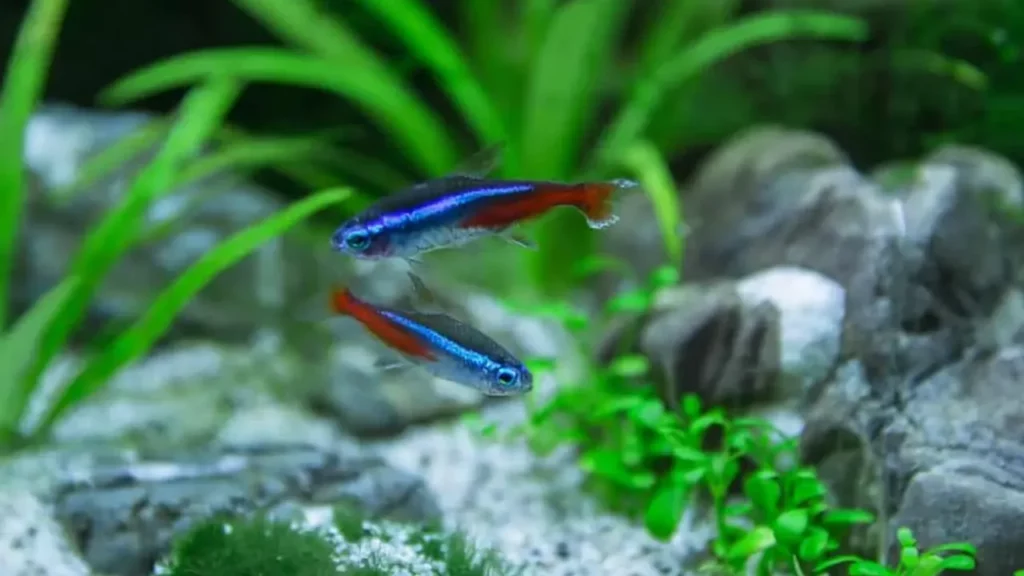
Physical Traits and Differences
Physical Traits and Differences
Gravid Spot: One of the most telltale signs in livebearers is the presence of a gravid spot. This darkened patch is located near the fish’s ventral area, just behind the abdomen. It becomes more pronounced when the fish is pregnant, indicating the presence of developing embryos within. Species like guppies, mollies, and platies often exhibit a pronounced gravid spot during pregnancy. Egg layers, on the other hand, do not exhibit this feature as their reproductive method doesn’t involve internal fertilization to the same degree.
Body Shape and Size: During the latter stages of pregnancy, livebearers often exhibit a noticeably distended abdomen, indicative of the growing fry within. Their body takes on a more rounded or squared-off appearance as they near giving birth. Egg layers might also show a fuller abdomen when carrying eggs, but this is often more transient, coinciding with the brief period leading up to egg-laying.
Fin Differences: While this isn’t a foolproof method, often, livebearers possess a modified anal fin known as a gonopodium. This fin, particularly pronounced in males, facilitates internal fertilization by transferring sperm to the female. Male egg layers typically do not have such a specialized fin and rely on external means of fertilization.
Behavioral Cues: While behavior might not be a physical trait per se, closely observing a fish’s actions can offer insights into its reproductive mode. Livebearers often exhibit mating behaviors like nipping or chasing. Egg layers, particularly those that care for their eggs, might be seen preparing or guarding specific spawning sites.
Behavior During Reproduction
Behavior During Reproduction
Livebearers’ Reproductive Rituals:
- Courtship Display: Male livebearers often engage in vibrant displays to woo potential mates. A male guppy, for instance, flaunts its colorful tail, fluttering it elegantly to catch the female’s eye.
- Chasing and Nipping: This can be both a game of affection and dominance. Males often pursue females, with brief, brisk swims, indicative of their interest and intent. Occasionally, nipping can be observed, a slightly more assertive form of courtship.
- Gonopodial Thrust: Recall the gonopodium, the modified anal fin in male livebearers? During mating, the male will swiftly align himself with the female and transfer sperm packets using this specialized fin, a process that is often quick but integral for internal fertilization.
Egg Layers’ Reproductive Rituals:
- Territoriality: Many egg-laying species become territorial during spawning times. They choose and defend specific nesting or spawning sites, ensuring a safe environment for their eggs. A classic example is the cichlid, which might even dig pits or clean rocks for the laying of eggs.
- Spawning Dance: In a breathtaking display of aquatic choreography, many egg layers engage in a synchronized dance. Take the case of our radiant Neon Tetras, who, amidst soft lighting and gentle water currents, align side by side, releasing and fertilizing eggs in harmony.
- Egg Guarding: Post-spawning, many egg layers, especially those termed ‘substrate spawners’, take on the noble role of guardians. They vigilantly watch over their eggs, fanning them with their fins to provide oxygen and chasing away potential threats. Some, like the endearing clownfish, even take turns with their partners in this nurturing act.
- Mouth Brooding: In a marvelous deviation from the norm, certain species, like specific African cichlids, practice mouth brooding. Post-fertilization, the female (or sometimes the male) scoops up the eggs in her mouth, offering a sanctuary till they hatch. Talk about parental dedication!
Examples of Livebearing Fish
Examples of Livebearing Fish
- Guppies (Poecilia reticulata): Often dubbed the ‘rainbow fish’, guppies are the poster children of livebearers. With their flamboyant tails and myriad color variations, they’re the true extroverts of the aquatic world. Males, especially, are known for their vibrant, multi-hued patterns, making them a favorite among aquarists.
- Mollies (Poecilia spp.): These are sociable and active fish, often seen darting joyously across tanks. Mollies come in various hues – from the shimmering silvers to the velvety blacks. They’re adaptable, congenial, and a joy to host in community tanks.
- Platies (Xiphophorus maculatus): Platies, with their stout bodies and vivacious personalities, are akin to the sunbeams of an aquarium. They come in a range of colors and patterns, including the popular sunset, tuxedo, and salt-and-pepper variations.
- Swordtails (Xiphophorus hellerii): Named for the elongated, ‘sword-like’ lower part of their tails, male swordtails are the cavaliers of the fish realm. They add a touch of drama and flair, with their distinct tails and assertive behaviors.
- Endler’s Livebearer (Poecilia wingei): A close cousin of the guppy, the Endler’s livebearer is an effervescent presence in tanks. With their neon-like color patterns and ceaseless energy, they’re nature’s tiny fireworks.
- Mosquitofish (Gambusia affinis): Don’t be fooled by the rather unflattering name. Mosquitofish are efficient predators of mosquito larvae, hence their moniker. Modest in size and appearance, they’re often employed in ponds or water bodies as a natural means of mosquito control.
Advantages of Egg Laying for Neon Tetras
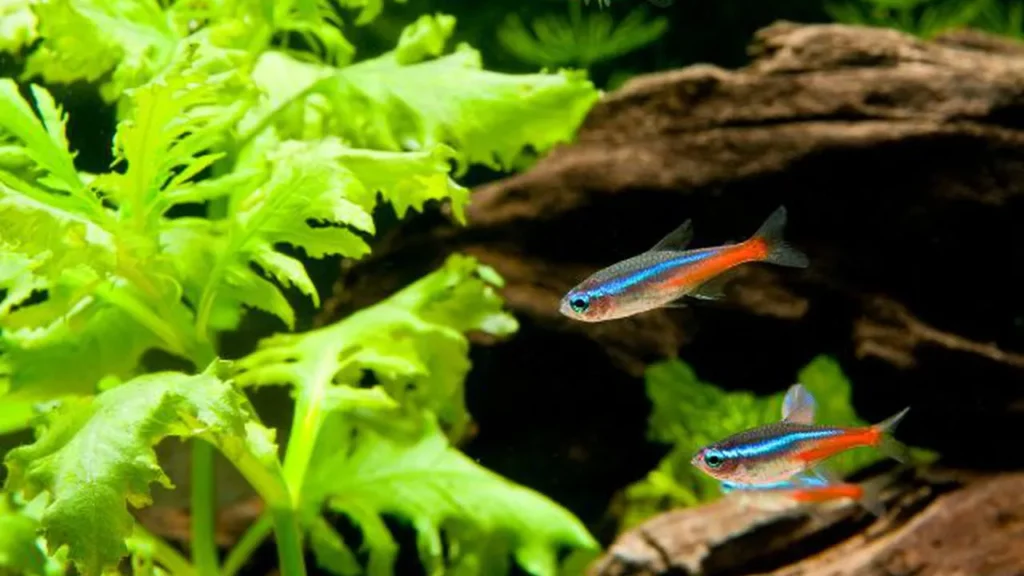
Predation Evasion
Predation Evasion
In the densely vegetated pockets of the Amazon basin, where Neon Tetras call home, the underwater realm is teeming with potential threats. Larger fish and other aquatic predators lurk in the shadows, ever-vigilant for their next meal. In such a world, ensuring the next generation’s survival becomes a critical endeavor.
Advantages of Egg Laying:
- Camouflage and Concealment: The eggs laid by Neon Tetras are relatively small and translucent, blending seamlessly with their surroundings. This natural camouflage offers them a cloak of invisibility against prying eyes.
- Distribution Strategy: When Neon Tetras spawn, they release a plethora of eggs. These eggs scatter amidst plants, substrate, and crevices. The sheer number and widespread distribution mean that while some eggs might fall victim to predators, a significant portion stands a good chance of evading detection and eventually hatching.
- Brief Exposure: The duration between laying and hatching is quite short for Neon Tetras (as we’ve previously explored). This limited window further reduces the chances of predation. Once the fry become free-swimming, they too exhibit evasive behaviors, darting into hiding at the slightest hint of danger.
- Parental Non-Attachment: Unlike some species that guard their eggs zealously (and might draw attention to them in the process), Neon Tetras do not exhibit strong parental instincts post-spawning. This ‘hands-off’ approach ensures that there’s no undue attention drawn to the freshly laid eggs.
Nature’s Balancing Act:
It’s fascinating how nature always seeks balance. In the vast, interconnected web of life, every species finds its rhythm, its strategies to persist and thrive. For Neon Tetras, egg laying offers a subtle yet effective way to tip the scales in favor of survival.
Large Clutch Sizes
- The Bountiful Release: During a single spawning event, a female Neon Tetra can lay anywhere from 60 to 130 eggs, sometimes even more. Now, that’s quite the impressive tally, isn’t it? This ‘scatter and hope’ approach ensures that even if a good number of eggs fall prey to other aquatic residents, a significant portion has a fighting chance at life.
- Nature’s Insurance Policy: The Amazon is unpredictable. With fluctuating water conditions, potential predators, and the ever-looming threat of environmental changes, laying a large clutch of eggs acts as an insurance of sorts. It’s the Neon Tetra’s way of hedging bets in favor of future generations.
- The Genetic Pool: With such a substantial number of offspring, there’s an increased genetic diversity within each batch. This variability is a treasure trove in evolutionary terms, allowing for adaptability and resilience in the face of changing environmental conditions.
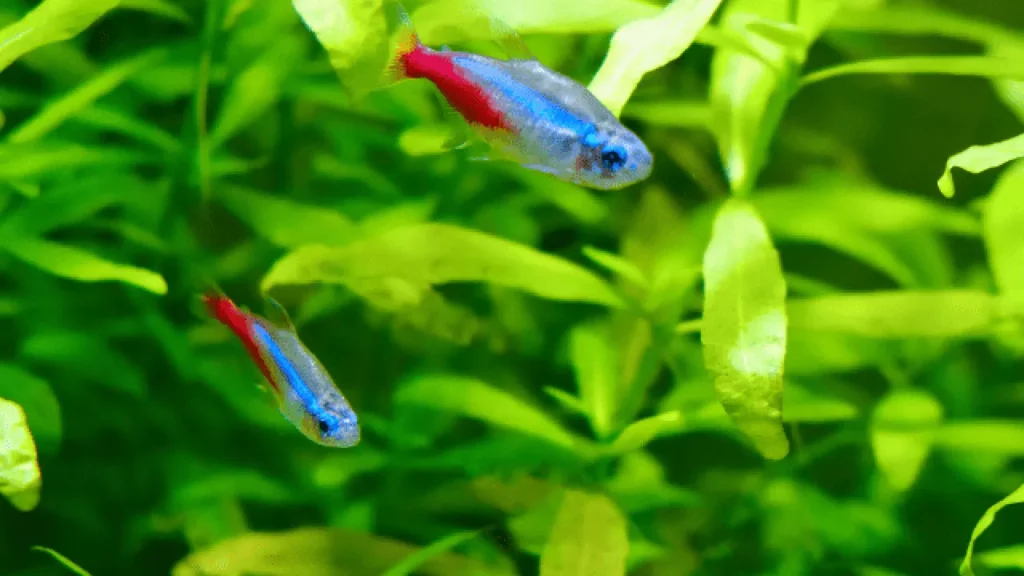
Breeding Neon Tetras in Captivity
Ideal Conditions for Spawning
Ideal Conditions for Spawning
Water Parameters:
- Temperature: To initiate spawning, consider a slight temperature increase. A range of 75°F to 80°F (24°C to 27°C) often does the trick, simulating the warmer influxes of water they’d naturally encounter during the breeding season.
- pH and Hardness: Neon Tetras prefer slightly acidic conditions for spawning. Aim for a pH level between 5.0 and 7.0. Soft water, which replicates their native habitat, is also crucial. A dGH (degree of General Hardness) of 1-2 is ideal.
- Dimmed Lighting: Recreate the dappled sunlight of the Amazonian undergrowth by providing subdued lighting. This not only sets the mood but also offers a sense of security and calm.
The Aquatic Environment:
- Leafy Lairs: Incorporate broad-leaved plants or spawning mops in your aquarium. These provide the perfect substrate for Neon Tetras to deposit their adhesive eggs. Java Fern and Anubias are splendid choices for this purpose.
- A Gentle Flow: These tetras are used to calm, meandering waters. A gentle water flow, preferably achieved using a sponge filter, mimics their natural habitat.
- Isolation or Breeding Tanks: If you’re serious about breeding, consider setting up a dedicated breeding tank. This ensures that once the eggs are laid, they can be safe from potential predators, including their own parents!
Dietary Delicacies:
- Live Foods: The way to a Neon Tetra’s heart (and successful spawning) is often through its stomach. Offering live foods like brine shrimp, daphnia, or bloodworms not only bolsters their health but also acts as an aphrodisiac of sorts.
- Variety: While live foods are vital, ensure a balanced diet with high-quality flake food, frozen delicacies, and even vegetable matter.
Fry Care Post-Hatching
Fry Care Post-Hatching
The moment of revelation, when tiny Neon Tetra fry emerge from their eggs, is nothing short of magical. But like every guardian of life’s fragile beginnings, you’re now entrusted with their care. These infinitesimal beings, with their silvery glint and innate curiosity, rely on us to recreate the nurturing embrace of the Amazon.
The First Moments:
- Infusoria, Nature’s Elixir: For the initial days, these fry are too small to consume standard foods. Infusoria – a collective term for tiny aquatic organisms – become their primary source of nutrition. While they can be introduced to the breeding tank before hatching, many aquarists also cultivate infusoria separately to ensure a steady supply.
- Gentle Aeration: Ensuring good oxygenation is paramount, but the water flow must remain gentle to avoid stressing or harming the delicate fry. A sponge filter, running at its lowest setting, can be quite effective here.
Gradual Dietary Transition:
- Microworms and Baby Brine Shrimp: As the fry grow over the next few days, they’ll need more substantial fare. Microworms and freshly hatched brine shrimp are excellent choices, packed with essential nutrients to fuel their rapid growth.
- Crushed Flakes: Once the fry are a couple of weeks old, finely crushed high-quality flake food can be introduced, supplementing their diet and ensuring a balanced nutrient intake.
Safety Measures:
- Hideouts for the Tiny: Providing ample hiding spots, like mosses and fine-leaved plants, can offer the fry a sense of security and refuge from potential threats.
- Regular Water Changes: Clean water is pivotal for the well-being of Neon Tetra fry. Frequent, small water changes (around 10% daily) using dechlorinated water can help maintain pristine conditions. But remember to match the temperature to avoid any sudden shifts.
- Monitor Tank Mates: If the fry aren’t in a dedicated breeding tank, be watchful of other tank inhabitants. While Neon Tetras are generally peaceful, the presence of larger fish might pose a threat to the fry.
The Beauty of Growth:
As days turn into weeks, you’ll witness an enthralling transformation. The fry will begin to display their characteristic neon stripe, a testament to their growth and the care you’ve provided. This journey, from fragile beginnings to vibrant juveniles, is one of nature’s most enchanting tales.
Frequently Asked Questions – FAQ
Give Us Feedback
Please help us get better by making suggestions or giving feedback, we really do listen to it!
